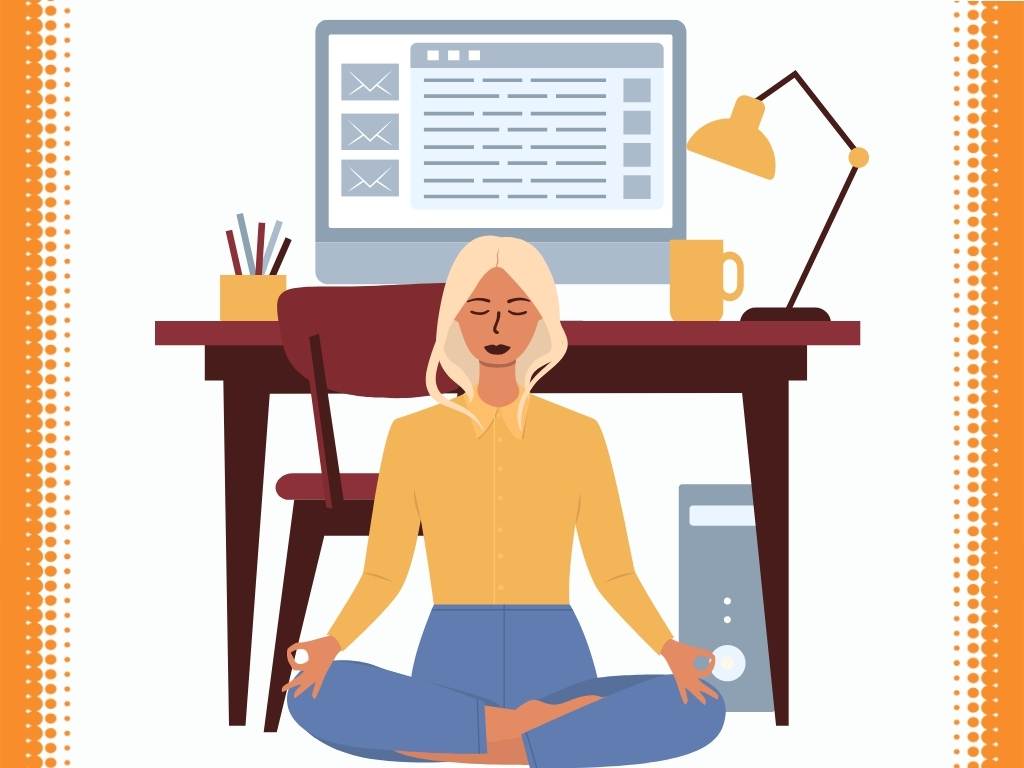How to Practice Mindfulness at Work
Have you recently heard the term “Great resignation” and wondered what’s going on? What is the whole world searching for? Inner peace at work? Is this the new reality or a fad that everyone is chasing?

The pandemic has been an eye-opener in various ways. Like any major devastating event in your life, this pandemic also stirred different emotions and now we are witnessing the repercussions. Starting from the core of your immune system to global supply chain dependencies, and the inevitable global shift of work from home situations.
Another most used word is Mindfulness. When you think of mindfulness, what image do you see? Sitting cross-legged, hands in a mudra, eyes closed and breathing deeply. So what is mindfulness at work? No, I am not asking you to sit cross-legged in your chair and close your eyes. That wouldn’t work.
If we examine the term mindfulness, it is the moment-to-moment awareness about your emotions, thoughts, breathing. So much of our life is spent living in the past or worrying about the future. Mindfulness is the connection with the present. So how can you implement these fundamental principles in the work scenarios?
Here are the top 3 guidelines, a collective of various visionaries and entrepreneurs who have researched and shared their knowledge in various books and other media.
1. SPOT, STOP, SWAP – The beginning of any change happens at the stage of awareness. We are living a life full of stress. Whether it is related to work, family, health or something as meagre as traffic.
A team of happiness researchers at the Vancouver School of Economics and McGill University recently published a working paper on the geography of well-being in Canada.
“Life is significantly less happy in urban areas,” the paper concluded.
Didn’t we move to the cities for a better prospect, better life? So what has gone wrong?
Be mindful and start spotting your stress triggers. Is it a nasty email? Is it your boss? Is it a particular person’s reaction or interaction? Identify what is causing you stress. We tend to generalize that work is causing us stress but when we dig deeper we will find that there are particular items, actions, inactions that are the root causes of the stress.
Once you identify the root cause the rest of the job is easy. Devise a strategy of how you would handle such situations in the future.
STOP at the next encounter of this stress trigger and then SWAP it with a mindful reaction.
This technique is explained by Jay Shetty in his book “Think like a monk”. Read the book for a deeper understanding.
2. Indistractable: Yes, you read that right. Strive to be indistractable. What does that mean? It simply means that no one or nothing can distract you from your task at hand.
Have you seen this word in the job descriptions “Great at multitasking”?
Science has now proven that multitasking is a myth. Every time you switch your attention from one task at hand to another task like an email, a text, a notification, or a slack message, it takes more effort and energy to bring back your attention to the task at hand.
Observe if you feel more agitated or irritated on a day when you receive too many emails or too many slack messages.
Every email/ every message does not need our immediate attention. It rather distracts us from the focus time from our work. So set up time slots to check emails and messages. You can set up do not disturb signs/alerts when you are researching/innovating or just need some deep focus time.
In this era of constant stimulation, it has become more important than ever to reclaim our focus time. When you remove the distractions, you will see substantial improvements in your work getting accomplished in less time.
Nir Eyal has discussed various techniques on how to reclaim your focus in his book “Indistractable”
3. Passion and learning: We have always heard that follow your heart, follow your passion. If you are passionate about your work, then the work becomes play. But not everyone is so fortunate to find a job in the area of their passion. So quite often that brings frustration, monotony, and boredom in your everyday work life.
What is the solution for that? No…. don’t resign and start backpacking.
Invest your free time in pursuing your passion. Invest that time in learning something new. It may be a language, painting, a new skill like carpentry, or a musical instrument. Try to search through your memories. What are the times that you remember to be extremely elated, happy, and rejoiced? What was that activity? Make a list and get going.
Try and bring back that activity into your life. Take a dance lesson just for the fun of swinging on the beats. Take out that guitar that has been stuck on the wall for years. Start brushing off your Spanish/French and enjoy the delicacy of the language.
The brain is made up of billions of nerve cells, called neurons. These cells are chatty. They “talk” to each other, mostly using chemical messengers. Incoming signals cause a listening neuron to fire or send signals of its own. Learning a new skill develops new neural pathways in your brain. The more you practice a new skill, the stronger the connection becomes.
There is now physical evidence using fMRI machines showing the new pathways being built in the brain when you learn a new skill, especially something like a musical instrument or a new language.
Pursuing your passion brings back that twinkle in your eyes. When you are excited about something that excitement lingers in your day-to-day life. It removes the boredom even at work, though your passion is unrelated to your work.
Read many exciting case studies shared by a brain surgeon in his book “Neuro Fitness” by Dr. Rahul Jandial.
Incorporating these 3 simple practices in your life would make a phenomenal difference in reducing your stress levels. So start today by practicing the mindfulness at work guidelines to create an environment of better productivity, less stress, and greater innovation.
